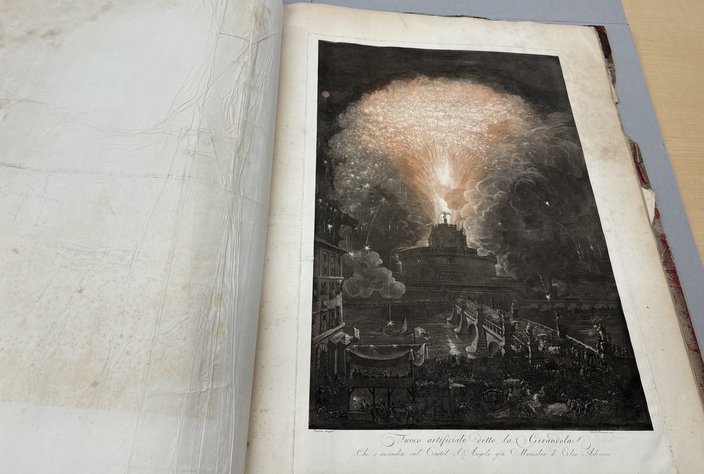Five years into its lengthy history as the nation’s oldest art school and museum, the Pennsylvania Academy of Fine Arts received a trunk of donations from Napoleon Bonaparte.
The case contained 25 volumes of etchings by Giovanni Battista Piranesi, one of the great printmakers of the 18th century. The Venetian artist rendered ancient Roman architecture, contemporary landmarks and structures he’d dreamt up in fine, detailed lines, making his work an ideal model for PAFA pupils trying to develop their own drawing skills.
- INSIDE THE ARCHIVES
- PhillyVoice peeks into the collections at different museums in the city, highlighting unique and significant items you won’t typically find on display.
What spurred the soon-to-be exiled French emperor to send these Italian masterworks overseas? Bonaparte entrusted his Piranesi collection to John Armstrong — the Revolutionary War veteran who served as U.S. ambassador to France during the Jefferson administration — with instructions to give the pieces to a “great public institution.” Armstrong decided the nascent PAFA was just the place.
Early American art schools
The volumes illustrate the tricky position the academy navigated during its early years. Though PAFA was formed in 1805 with the goal of cultivating fine art in America, the fledgling nation had barely established movements and masters. So the art school leaned on European works to educate its student body.
To obtain that vital educational material, the PAFA founders tapped their connections abroad. Nicholas Biddle, the younger brother of co-founder William Biddle, sent the school a collection of plaster casts from Paris. The set included replicas of the ancient Roman sculpture “Laocoön and His Sons” and Greek classic “Venus de’ Medici,” plus commissions from the Louvre’s official plaster caster. These copies of famous works allowed students access, or the next best thing, to the masters at a time when the only alternative was boarding a ship to Europe.
Prints like Piranesi’s also aided this mission. His elaborate and sometimes exaggerated renderings of Rome were so striking that tourists like the German writer Johann Wolfgang von Goethe were disappointed by the real city. The volumes in the PAFA collection include pages that fold out to reveal even longer prints of Roman ruins. Works from other members of the Piranesi family also appear. His son Francesco used red ink to make the fireworks in his 1790 print, based off a Louis-Jean Desprez composition, burn brighter.

This Francesco Piranesi etching depicts a fireworks show behind the Castel Sant’Angelo in Rome.
“You need a library for your resources,” said Hoang Tran, director of PAFA’s archives, library and collections. “There was no Google, there was no Wikipedia, so you had to really have the resources here. America was still pretty young, you know, 1776 versus 1805. So we still were having this look back into European ideas and what was fine art at the time. We didn’t really have an American art, per se, yet.”
Stepping into the future
PAFA offered its first classes in a white marble neoclassical building on Chestnut Street, though as Tran notes, its education model was quite different than the ones favored today. He describes it as more of a “training ground.” Students might attend class for a week or two, but after that they would “keep asking permission to come in” to study the casts in the museum galleries, sketch copies and/or ask the instructors for feedback. Though PAFA didn’t officially charge tuition until the late 19th century, its pupils tended to come from wealthy families, ones that “most likely” would’ve sent them to study art in Europe prior to PAFA’s founding, Tran said.
PAFA moved into a new building on Cherry and Broad streets in 1876, where it still resides today. But things really started to change when PAFA alum Thomas Eakins — the namesake for the Eakins Oval on Benjamin Franklin Parkway — returned to the school around the same time. As the new director, he created an organized program of classes, printed in a course catalog and designed according to student experience. He also pushed his students to work off human figures rather than casts and introduced sculpture classes with live nude models. While this emphasis on nudity ultimately got him fired, many of his changes remained in place after he left the school.
“That is what I would argue is more of the American idea,” Tran said. “You’re finding your footing. You’re not looking to Europe anymore. … Because we had, what, 60 years of growth here with the academy, other art schools in America, in New York, and such places that we really had a new American art movement.”
PAFA graduates like Henry Ossawa Tanner and Mary Cassatt contributed to this new American art movement, but the legacy continued past the late 19th and early 20th centuries. David Lynch, the recently deceased surrealist filmmaker, attended the school in the 1960s before making his feature debut with “Eraserhead.”
The museum and school is continuing to modernize with a series of upgrades, largely to its HVAC system, currently underway. (The staff hopes to reopen its historic building, closed since July 2024, in time for its 150th anniversary in 2026.) But in other ways, it’s returning to older traditions. In 2024, PAFA announced it would phase out its bachelor’s and master’s degree programs. Students can still earn a BFA through a dual program with the University of Pennsylvania, or pursue a certificate more reminiscent of the school’s “training ground” past.
“We’re just going back to our roots,” Tran said. “We were an academy. We trained artists, serious artists. So we are removing the humanities aspects, the liberal arts, things like that.
“We are a dual mission institution and that hasn’t changed.”
Follow Kristin & PhillyVoice on Twitter: @kristin_hunt
| @thePhillyVoice
Like us on Facebook: PhillyVoice
Have a news tip? Let us know.

